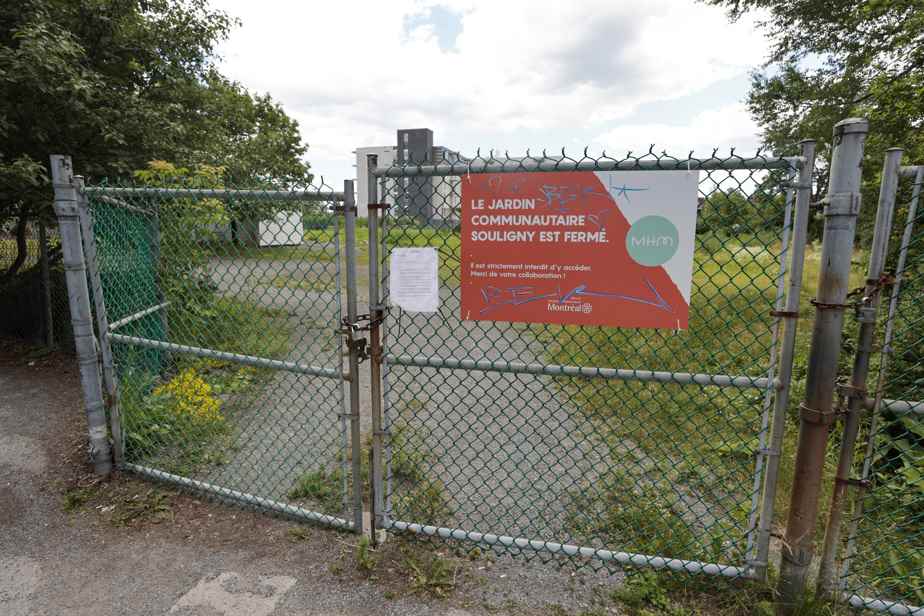Citizens are raising their voices after the closure of the Souligny community garden, in Mercier–Hochelaga-Maisonneuve, due to the construction of a real estate project. Supported by an opposition adviser, they claim to be able to continue to have access to a portion of the garden despite the construction site.
Posted at 3:42 p.m.
“If the mayor had held a public consultation before closing the garden, he would have seen that it is difficult for many of us to get around,” says area resident Franz Charneux.
Former president of the Souligny community garden, this citizen regrets that the City acted without taking into account the will of the population, by completely closing access to the site as of June 13. “The reality is that it seems to have worked for them, because when I tried to bring this issue to them, I was told that there is already a waiting list for [le jardin communautaire] Clément-Jetté”, he berates.
Located nearby, this other garden is however difficult to access for several citizens who suffer from handicaps or other health problems, according to the citizen. It is a vast real estate project, located in the former Honoré-Beaugrand road yard, which forced the closure of the Souligny garden. The developer plans to build nearly 300 housing units there. The City claims to have informed residents of the situation almost two years ago, in the fall of 2020, that they will have to find a new space.
“Crying” needs
The citizens and the councilor of Tétreaultville, Julien Hénault-Ratelle, denounce however that about thirty gardens – located “under the shelter of the construction site” – are closed when they could be open to the public in complete safety. What’s more, “this garden is located in one of the districts of the borough where the needs in terms of food access are the most glaring”, criticizes the elected official.
“With inflation and the waiting time that amounts to several years to obtain a space in a community garden in Montreal, it makes no sense to close wall-to-wall this space which makes a real difference for many families who live in low-rent housing,” he adds, calling for “real consultation.”

PHOTO MARTIN CHAMBERLAND, THE PRESS
Aerial view of the construction site and what remains of the Souligny community garden.
Mr. Hénault-Ratelle also complains that no post-construction project has yet been presented to citizens, as the work should last at least three years. A petition signed by 160 people should be tabled by Mr. Charneux at the next borough council meeting, which is scheduled for July 4.
In the office of the mayor of the borough, it is reiterated that the project has already passed before the Office of public consultation of Montreal (OCPM). “All those eligible for the Souligny garden have been relocated to the Clément-Jetté garden with a new space”, affirms the press officer, Laury Chayer, specifying that the Souligny garden “has always been intended for a temporary activity”.
Twenty gardens out of the 125 were already “contaminated”, recalls the borough, and none of them had universal access, unlike the Clément-Jetté garden, which has 147 healthy gardens. “Housing construction is done in multiple phases, so instead of removing people in rushed and disorganized conditions, the borough found it more responsible to shut down and make sure there was another space, with no breakage of service”, insists Mme Chayer.
The craze for urban gardening is currently very strong, especially since the COVID-19 pandemic. Last April, the firm Angus Reid showed in a survey that more than one million Canadian households want to learn gardening in 2022, a number which is added to that of gardeners converted during the pandemic and before.
But there is the other side of the coin. In May, Radio-Canada revealed that the wait for a place in a community garden is on the rise in Montreal. In some very dense sectors like Côte-des-Neiges–Notre-Dame-de-Grâce, you have to wait between six and ten years before getting a place. Ditto on the Plateau-Mont-Royal (7-10 years) or Verdun (3-4 years). Further north, the situation is more tolerable; you have to wait one to three years in Ahuntsic-Cartierville.
“While in 2020, food insecurity was a strong argument to encourage people to grow their food at home, this consideration is partially redirected to concerns about food affordability and freshness,” explained in April the Director of the Laboratory of Analytical Sciences in Agrifood, Sylvain Charlebois.

